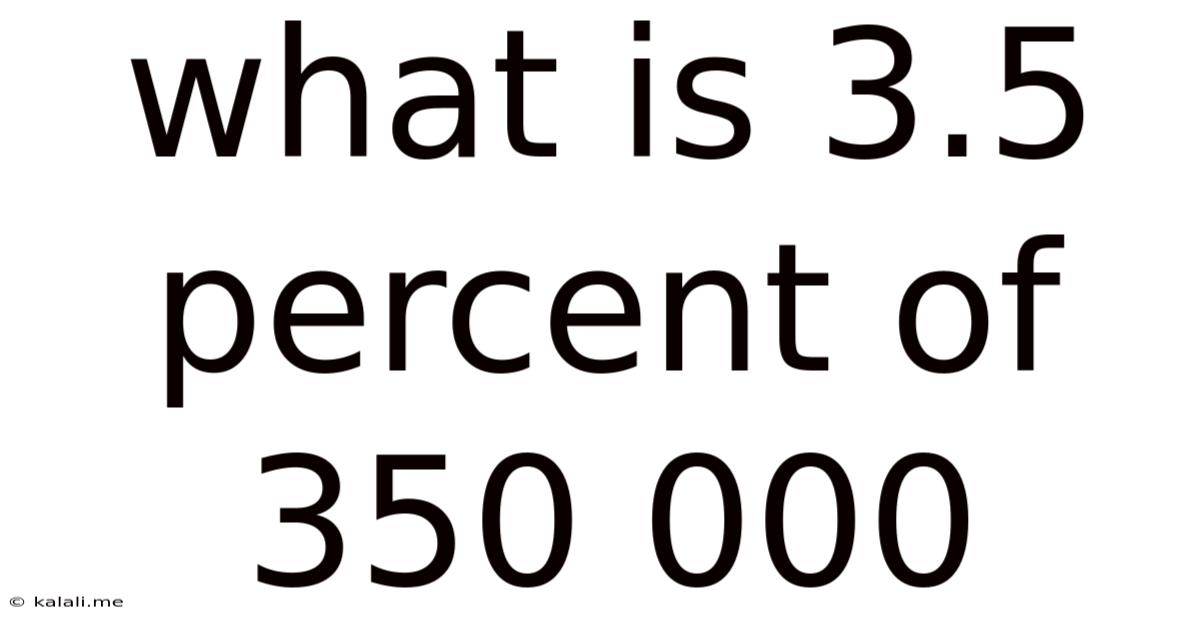What Is 3.5 Percent Of 350 000
Kalali
Jul 21, 2025 · 4 min read

Table of Contents
What is 3.5 Percent of 350,000? A Comprehensive Guide to Percentage Calculations
Finding a percentage of a number is a fundamental mathematical skill with wide-ranging applications in everyday life, from calculating sales tax and discounts to understanding financial reports and analyzing statistical data. This article delves into the calculation of 3.5 percent of 350,000, providing not only the answer but also a comprehensive explanation of the method, its variations, and practical real-world examples. Understanding this seemingly simple calculation unlocks a broader understanding of percentages and their importance in various fields.
Meta Description: Learn how to calculate 3.5% of 350,000. This comprehensive guide explains the method, provides the answer, explores real-world applications, and offers alternative calculation strategies for various percentage problems.
Understanding Percentages
Before we dive into the specific calculation, let's establish a clear understanding of what percentages represent. A percentage is a fraction or ratio expressed as a number out of 100. The symbol "%" signifies "percent," meaning "per hundred." So, 3.5% means 3.5 out of every 100. This representation allows for easy comparison and understanding of proportions. For instance, if a store offers a 10% discount, it means you'll pay 90% of the original price (100% - 10% = 90%).
Calculating 3.5% of 350,000: The Basic Method
The most straightforward method to calculate 3.5% of 350,000 involves converting the percentage to a decimal and then multiplying it by the number.
Step 1: Convert the Percentage to a Decimal
To convert a percentage to a decimal, divide the percentage by 100. In this case:
3.5% ÷ 100 = 0.035
Step 2: Multiply the Decimal by the Number
Now, multiply the decimal (0.035) by the number (350,000):
0.035 x 350,000 = 12,250
Therefore, 3.5% of 350,000 is 12,250.
Alternative Calculation Methods
While the above method is the most common and readily understood, there are alternative approaches that can be useful depending on the context and individual preference.
Method 2: Using Fractions
Percentages can also be expressed as fractions. 3.5% can be written as 3.5/100 or simplified to 7/200. Then, the calculation becomes:
(7/200) x 350,000 = 12,250
This method might be preferable for those comfortable working with fractions and might offer a clearer understanding of the proportional relationship.
Method 3: Breaking Down the Percentage
For larger percentages or those involving decimal places, breaking down the calculation into smaller, easier-to-manage parts can be helpful. For instance, we can calculate 3% of 350,000 and then 0.5% of 350,000 separately and add the results.
- 3% of 350,000: 0.03 x 350,000 = 10,500
- 0.5% of 350,000: 0.005 x 350,000 = 1,750
- Total: 10,500 + 1,750 = 12,250
This method enhances understanding and provides a useful check for accuracy.
Real-World Applications: Illustrative Examples
The ability to calculate percentages is crucial across numerous real-world scenarios. Here are some examples showcasing the practical applications of this skill:
1. Financial Calculations:
- Investment Returns: Imagine you invested 350,000 in a fund that yielded a 3.5% return. Using the calculation above, you would know your profit is 12,250.
- Loan Interest: Understanding percentage calculations is essential for calculating interest payments on loans. A 3.5% interest rate on a 350,000 loan would significantly impact monthly payments.
- Tax Calculations: Calculating sales tax, income tax, or property tax often involves determining a percentage of a total amount.
2. Business and Commerce:
- Profit Margins: Businesses use percentage calculations to determine profit margins, which represent the percentage of revenue remaining after deducting costs.
- Sales Discounts: Stores often offer discounts expressed as percentages. Calculating the discounted price requires finding a percentage of the original price.
- Market Share Analysis: Companies use percentage calculations to analyze their market share and compare it to competitors.
3. Everyday Life:
- Tip Calculations: Calculating a tip in a restaurant often involves finding a percentage of the bill.
- Discount Offers: Understanding percentages allows consumers to quickly determine the savings from discounted items.
- Grading Systems: Many educational systems use percentages to represent grades, allowing for easy comparison of academic performance.
Expanding Your Percentage Skills: Further Exploration
Mastering percentage calculations opens doors to more advanced concepts. Here are some areas for further exploration:
- Calculating Percentage Increase or Decrease: This involves finding the percentage change between two numbers. This is particularly useful when comparing data over time or analyzing growth trends.
- Finding the Original Amount: If you know the percentage and the resulting amount, you can work backward to determine the original number.
- Compound Interest: This concept involves earning interest on both the principal and accumulated interest. Understanding compound interest is crucial for long-term financial planning.
Conclusion: The Power of Percentage Calculations
The seemingly simple calculation of 3.5% of 350,000, yielding 12,250, is a gateway to understanding a powerful mathematical concept with far-reaching applications. By mastering various methods for calculating percentages and understanding their real-world applications, individuals can enhance their financial literacy, improve their business acumen, and make better-informed decisions in everyday life. From analyzing investment returns to understanding discounts, the skill of calculating percentages is an invaluable asset in the modern world. Continue to practice and explore the different methods to solidify your understanding and confidently tackle a wide range of percentage problems.
Latest Posts
Latest Posts
-
How Much Land Do The Robertson Family Own
Jul 22, 2025
-
How To Write 1 Million In Figures
Jul 22, 2025
-
Drop A Heart Break A Name Meaning
Jul 22, 2025
-
When Does The Condensing Pressure Stop Rising
Jul 22, 2025
-
Why Is My Hamster Trying To Escape
Jul 22, 2025
Related Post
Thank you for visiting our website which covers about What Is 3.5 Percent Of 350 000 . We hope the information provided has been useful to you. Feel free to contact us if you have any questions or need further assistance. See you next time and don't miss to bookmark.